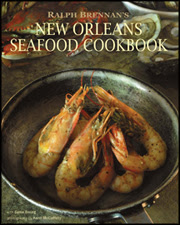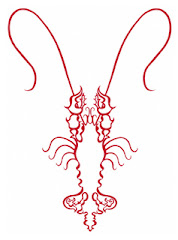 Ralph Brennan's New Orleans Seafood Cookbook includes everything New Orleans, including the city's most famous cocktails. Perhaps the oldest recipe among them is the Sazerac, a rye whiskey-based drink that is flavored with Peychaud's bitters and Herbsaint anisette liqueur on page 401.
Ralph Brennan's New Orleans Seafood Cookbook includes everything New Orleans, including the city's most famous cocktails. Perhaps the oldest recipe among them is the Sazerac, a rye whiskey-based drink that is flavored with Peychaud's bitters and Herbsaint anisette liqueur on page 401.Chuck Taggart of Gumbo Pages had this to say about the Sazerac experience:
This is an absolutely exquisite cocktail. As you sip it, you come across layer after layer of flavor -- the warmth and glowing burn of the rye, effused with the flavors of spice and honey, the bite of the bitters balanced with the sweetness of the sugar, with the subtle yet complex flavor of the anise underneath and the perfume of the lemon oil from the twist feel like a symphony inside your mouth. This is also a drink that warms up well, revealing even more flavors. Sip it very slowly. Savor it. Take your time with it.
The drink quickly became a staple in the city's coffee houses (read: Bars). At Wikipedia, it's stated that in 1859, John Schiller opened the Sazerac Coffee House in the French Quarter. Schiller also had a sideline in the sales of a French cognac called Sazerac-de-forge et fils and he used this brandy with Peychaud's bitters. The drink eventually came to be known by the name of the coffee house where it was served.
The drink underwent a change in 1870. A gentleman by the name of Thomas Handy took over the Sazerac Coffee House. With changing tastes and a new difficulty in getting cognac, rye whiskey became the base of the drink. Handy formed the Sazerac Company as well, buying the Peychaud Family's bitters recipe along with the bar. An absinthe coating of the glass was introduced at this time as well, the final evolution of the drink we know today.
While Hurricanes are the drink most commonly associated with the city of New Orleans, Chuck Taggart observes that "Hurricanes are for tourists. Sazeracs are for natives." The Sazerac is viewed as the quintessential New Orleans cocktail and was under consideration for the title of official cocktail of the State of Louisiana. On April 10, 2008, The Daily Illini in a post from the AP newswire reported that an effort had been made by Senator Ed Murray to declare the drink the official state cocktail. Due to concerns of the state's image, the Louisiana State Senate voted the legislation down in a vote of 27-8.
While not officially recognized, the people of New Orleans hold the drink close to their hearts. Ralph Brennan's New Orleans Seafood Cookbook advises using Old Overholt rye whiskey in preparing the Sazerac.
Gumbo Pages: "The Original Sazerac Cocktail"
The Spirit World: "Sazerac" 05/29/06
Wikipedia: "Sazerac (cocktail)" 04/09/08
The Daily Illini: "Odds and Ends: Senate Rejects Bill Making Sazerac Official La. Cocktail" 04/10/08
photo courtesy of Lee Coursey, used under this Creative Commons license



























